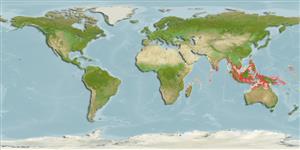Common names from other countries
Elasmobranchii (tubarões e raias) (sharks and rays) >
Myliobatiformes (Stingrays) >
Gymnuridae (Butterfly rays)
Etymology: Gymnura: Greek, gymnos = naked + Greek, oura = tail (Ref. 45335).
More on author: Bleeker.
Environment: milieu / climate zone / depth range / distribution range
Ecologia
marinhas associadas(os) a recifes; intervalo de profundidade 28 - 37 m (Ref. 9918). Tropical
Eastern Indian Ocean and Western Central Pacific: India to Indonesia, including Singapore and Thailand.
Length at first maturity / Tamanho / Peso / Idade
Maturity: Lm 47.6, range 47 - ? cm
Max length : 106 cm WD macho/indeterminado; (Ref. 58048); common length : 20.0 cm WD macho/indeterminado; (Ref. 27550)
Demersal inshore, in shallow depths to at least 37 m (Ref.58048). Also found offshore (Ref. 9918). Ovoviviparous (Ref. 50449). Smallest individual was 27 cm WD. Caught often by demersal trawl, trammel and gillnet fisheries, and occasionally using tangle nets. Utilized for its meat, but of limited value due to its typically small size (Ref.58048).
Life cycle and mating behavior
Maturities | Reprodução | Spawnings | Egg(s) | Fecundities | Larvas
Exhibit ovoviparity (aplacental viviparity), with embryos feeding initially on yolk, then receiving additional nourishment from the mother by indirect absorption of uterine fluid enriched with mucus, fat or protein through specialised structures (Ref. 50449). Distinct pairing with embrace (Ref. 205).
Compagno, L.J.V., 1999. Checklist of living elasmobranchs. p. 471-498. In W.C. Hamlett (ed.) Sharks, skates, and rays: the biology of elasmobranch fishes. Johns Hopkins University Press, Maryland. (Ref. 35766)
Categoria na Lista Vermelha da IUCN (Ref. 130435)
CITES (Ref. 128078)
Not Evaluated
Utilização humana
Pescarias: espécies comerciais
Ferramentas
Relatórios especiais
Descarregue XML
Fontes da internet
Estimates based on models
Preferred temperature (Ref.
115969): 27.2 - 28.8, mean 28.2 (based on 91 cells).
Phylogenetic diversity index (Ref.
82804): PD
50 = 0.5000 [Uniqueness, from 0.5 = low to 2.0 = high].
Bayesian length-weight: a=0.00776 (0.00352 - 0.01710), b=3.09 (2.89 - 3.29), in cm Total Length, based on LWR estimates for this (Sub)family-body shape (Ref.
93245).
Nível Trófico (Ref.
69278): 3.8 ±0.6 se; based on size and trophs of closest relatives
Resiliência (Ref.
120179): Muito baixo, tempo mínimo de duplicação da população maior que 14 anos (Fec assumed to be <10).
Fishing Vulnerability (Ref.
59153): Moderate to high vulnerability (51 of 100).
